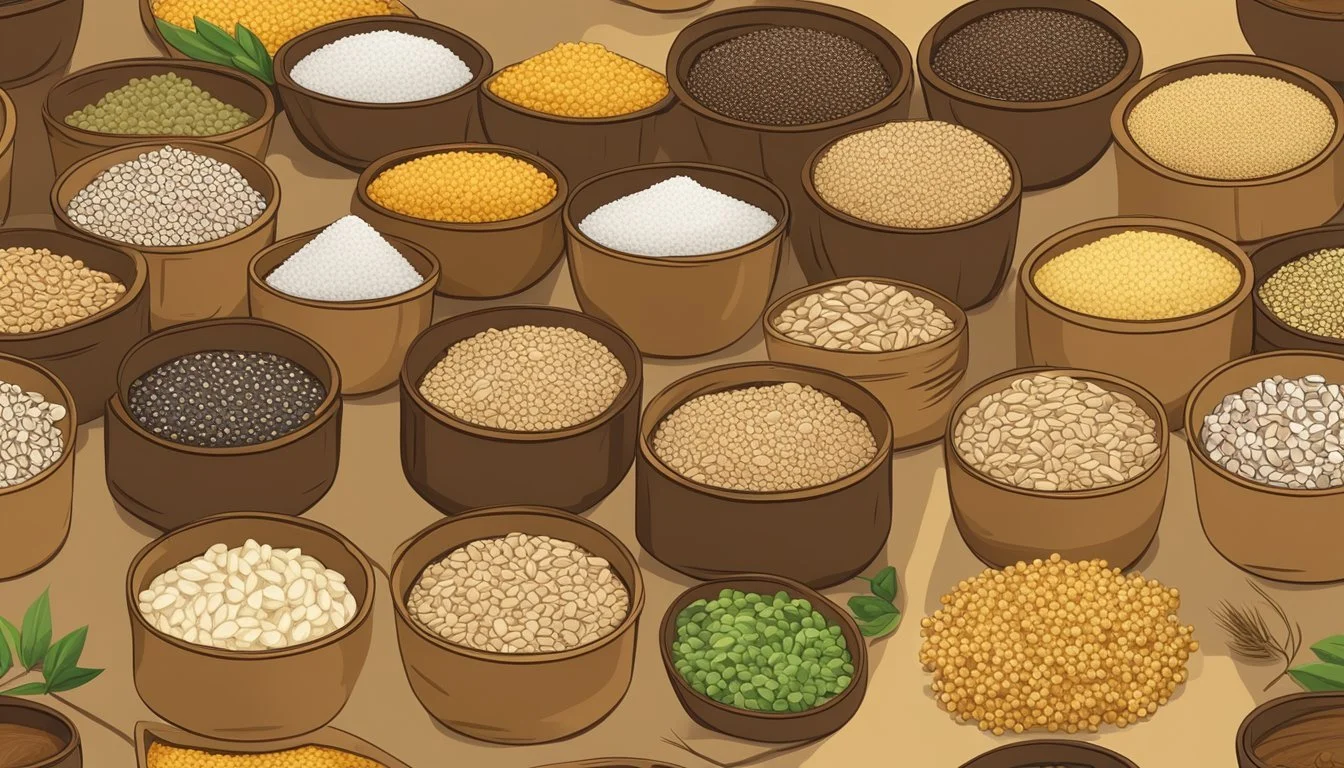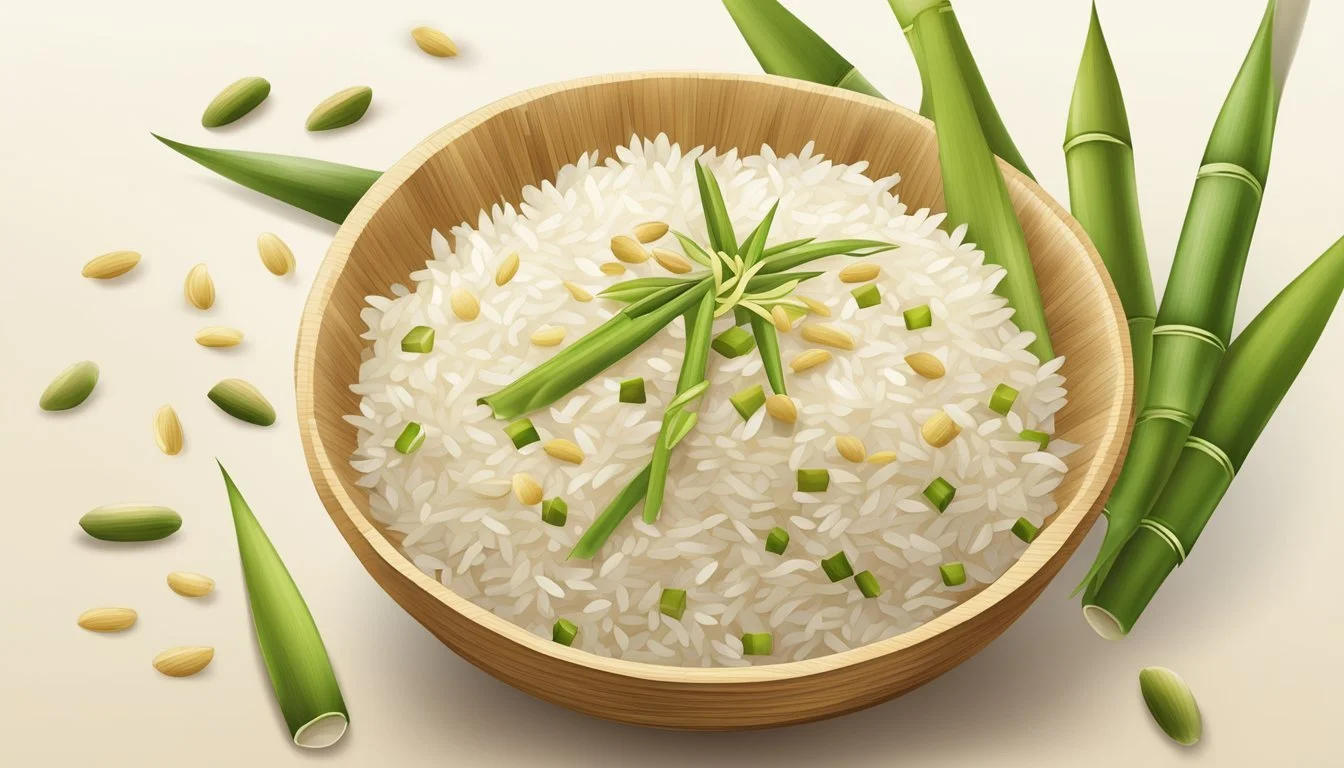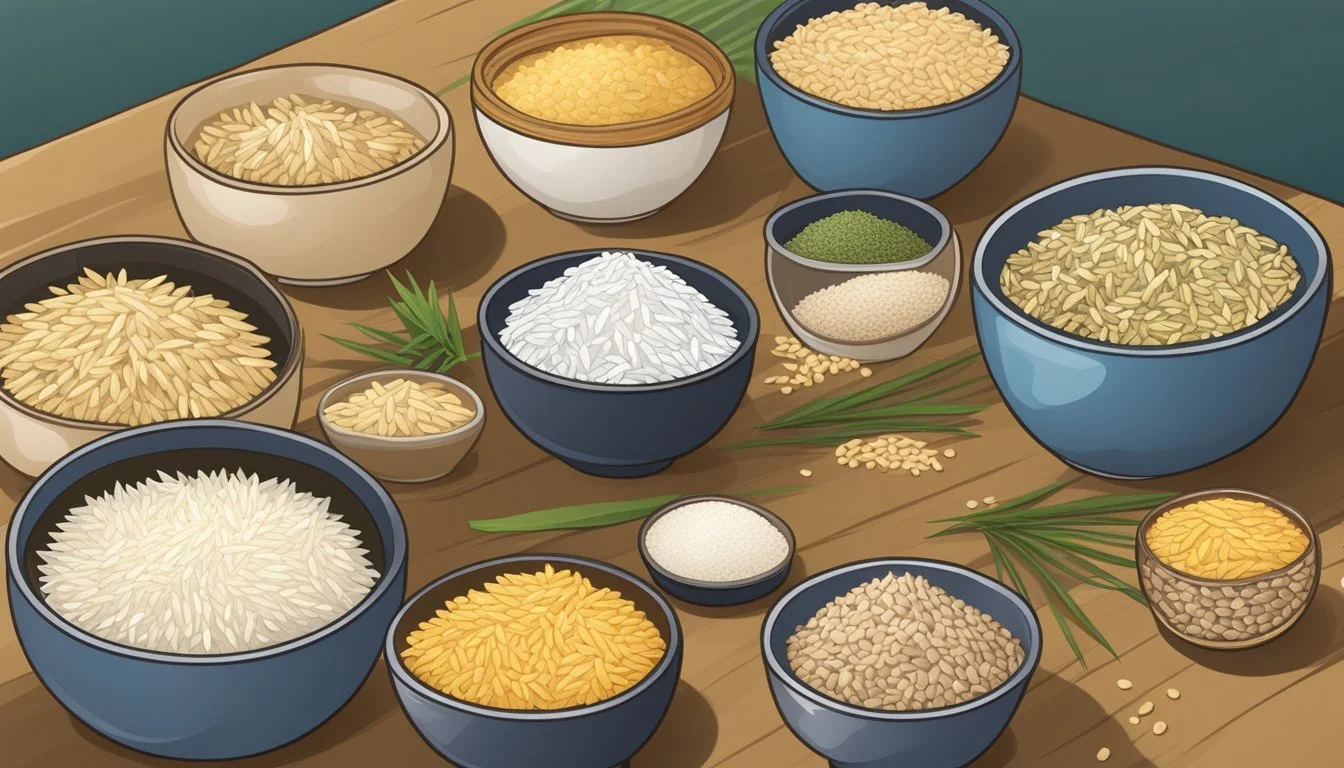Bamboo Rice Substitutes
Top Alternatives for Your Recipes
Looking to explore new grain alternatives? Bamboo rice substitutes can be an exciting addition to your culinary repertoire. Whether you're looking for a change due to dietary preferences or simply want to try something different, these alternatives offer unique flavors and nutritional benefits that can enhance your meals.
For those who appreciate the nutty taste of bamboo rice, quinoa can be a great alternative. Quinoa is rich in protein and fiber, making it an excellent choice for those seeking a nutritious rice substitute. It cooks easily and pairs well with a variety of dishes, from salads to hearty stews.
Another great substitute is chopped cabbage, which is low in calories and carbs yet provides a satisfying texture. It can be easily incorporated into diverse cuisines, complementing dishes like stir-fries and salads without overwhelming the other ingredients. This makes it a practical option for those looking to reduce their carbohydrate intake while still enjoying hearty and flavorful meals.
The Need for Bamboo Rice Substitutes
Bamboo rice, derived from the seeds of dying bamboo shoots or white rice treated with bamboo juice, presents a unique flavor and texture. However, there are various reasons why individuals seek substitutes for bamboo rice.
One primary reason is dietary needs. Bamboo rice may not align with specific diets, such as those requiring low-carb or gluten-free options. Finding alternatives that fit these criteria is essential for maintaining dietary restrictions.
Moreover, some individuals seek alternatives for health reasons. While bamboo rice is nutritious, others might prefer rice substitutes that offer additional health benefits or address certain medical conditions.
Rice alternatives also cater to those looking to diversify their meals or enhance the nutritional profile of their diet. Here are some common substitutes:
Quinoa: High in protein and gluten-free.
Cauliflower rice: Low-carb and suitable for ketogenic diets.
Brown rice: Offers more fiber compared to bamboo rice.
These substitutes not only meet specific dietary preferences but also add variety to one’s meal plan.
Characteristics of Bamboo Rice
Bamboo rice is a unique grain characterized by its nutritional richness, distinct nutty flavor, and versatility in various culinary applications.
Nutritional Profile
Bamboo rice offers a balanced nutritional profile, making it a healthy choice. It is rich in carbohydrates that provide energy and contains moderate amounts of protein. This grain is also a good source of fiber, which aids in digestion.
Bamboo rice includes several essential nutrients like magnesium, iron, and calcium, contributing to overall health. Additionally, it features essential amino acids, which are crucial for body functions. Though it contains a lower amount of vitamin C, the presence of these minerals makes it a valuable addition to a balanced diet.
Flavor and Texture
Bamboo rice has a distinctive nutty flavor that sets it apart from regular rice. The flavor profile is slightly more pronounced, offering a subtly sweet undertone. When cooked, bamboo rice has a chewy texture, which adds a unique element to the dishes it is used in.
The grains of bamboo rice are slightly shorter and thicker compared to traditional rice varieties, which contributes to its unique mouthfeel. This texture makes it particularly suitable for dishes that benefit from a bit more body and substance.
Culinary Uses
Bamboo rice is versatile and can be used in a wide range of dishes. It can replace regular rice in recipes, offering a different flavor and texture profile. Pilafs, stir-fries, and soups benefit from the inclusion of bamboo rice.
Due to its chewy texture, bamboo rice is also suitable for salads where a more substantial grain is desired. It does not require soaking before cooking, simplifying preparation. Adding washed bamboo rice to boiling water and simmering it yields the best results, making it easy to integrate into various culinary traditions.
Grains as Substitutes
When looking for alternatives to bamboo rice, various grains offer unique benefits and flavors, making them suitable for diverse dietary needs. These grains can provide additional nutrients like protein, fiber, and essential minerals while maintaining different textures and taste profiles.
Quinoa
Quinoa is a versatile, protein-rich grain often used as a rice substitute. It is a complete protein, containing all nine essential amino acids, making it an excellent choice for vegetarians and vegans. Quinoa is also high in dietary fiber and provides important minerals like magnesium and iron. It cooks quickly, usually in 15-20 minutes, and has a slightly nutty flavor that complements various dishes. Its ability to absorb flavors makes quinoa a popular choice in salads, soups, and main courses.
Barley
Barley is a whole grain known for its chewy texture and nutty flavor. It is high in dietary fiber, particularly beta-glucan, which can help lower cholesterol levels. Barley also contains essential vitamins and minerals, such as B vitamins, iron, and magnesium. It takes longer to cook, typically around 45 minutes, but the nutritious benefits are notable. It is often used in soups, stews, and salads, providing a hearty alternative to rice with fewer carbs.
Farro
Farro is an ancient grain with a distinct, chewy texture and a rich, nutty taste. It is considered a whole grain when left unprocessed and offers numerous health benefits, including high dietary fiber and protein content. Farro also supplies magnesium, zinc, and B vitamins. It generally takes about 30-40 minutes to cook and works well in salads, soups, and as a side dish. Due to its hearty nature, farro is a satisfying and nutritious rice substitute.
Bulgur Wheat
Bulgur wheat is a staple in Middle Eastern cuisine, known for its quick cooking time and tender texture. It is made from whole wheat kernels that are parboiled, dried, and cracked, which allows it to cook in about 10-15 minutes. Bulgur is high in dietary fiber and offers more protein than brown rice. It contains various vitamins and minerals, such as manganese and magnesium. It is ideal for use in salads, like tabbouleh, pilafs, or as a side dish.
Freekeh
Freekeh is a whole grain made from green wheat that is harvested while young, roasted, and threshed. This process gives it a smoky flavor and chewy texture. Freekeh is rich in protein, dietary fiber, and essential minerals like iron and zinc. It typically takes about 20-25 minutes to cook and is known for its low glycemic index, making it a good option for those looking to manage blood sugar levels. It is suitable for soups, stews, and salads.
Wild Rice
Wild rice, despite its name, is technically a grass seed rather than true rice. It has a firm texture and a nutty flavor. Wild rice is high in protein, higher than most grains and offers significant dietary fiber and important minerals like phosphorus and magnesium. Wild rice usually takes longer to cook, around 45-60 minutes, but its rich nutrient profile makes it worth the wait. It can be used in salads, soups, casseroles, and as a side dish.
Using these grains as substitutes for bamboo rice can offer a variety of textures and flavors while providing substantial nutritional benefits. Each grain has unique properties that can complement different culinary traditions and dietary requirements.
Vegetable-Based Substitutes
Vegetable-based alternatives to bamboo rice offer low-carb, nutrient-rich options suitable for various diets. These substitutes provide essential vitamins, are versatile in various dishes, and cater to vegetarian and keto lifestyles.
Cauliflower Rice
Cauliflower rice is a popular low-carb substitute for traditional rice. Made by grating or processing cauliflower florets, this rice alternative is low in calories and carbs, with just 1.5 grams of net carbs per 100 grams.
It serves as an excellent source of vitamins C and K, with 100 grams providing about 77% of the daily recommended intake for vitamin C. The mild flavor of cauliflower makes it versatile for various cuisines, enhancing curry dishes, stir-fries, and salads.
Broccoli Rice
Broccoli rice, made by pulsing broccoli florets in a food processor, is another nutritious rice alternative. This substitute is low in carbs and calories, with roughly 30 calories and 6 grams of carbs per cup.
Broccoli rice is rich in vitamins C and K, contributing to immune support and bone health. Its slightly stronger flavor compared to cauliflower rice makes it an excellent addition to hearty soups and stews or as a side dish with lean proteins in keto or vegetarian diets.
Chopped Cabbage
Chopped cabbage is a versatile option for those seeking a low-carb, low-calorie rice substitute.
Cabbage is packed with fiber and vitamins, including vitamins C and K, providing approximately 54% and 85% of the daily values per 100 grams, respectively. Its mild taste pairs well with diverse cuisines, making it suitable for salads, soups, and stir-fries. Chopped cabbage not only fits into vegetarian and keto diets but also supports digestive health due to its high fiber content.
It’s an ideal choice for those looking to incorporate a nutrient-dense, low-calorie base into meals.
Legume and Seed Substitutes
Legumes and seeds can provide valuable proteins and fibers, making them excellent substitutes for bamboo rice. Substituting bamboo rice with legumes or seeds adds nutritional benefits like plant-based proteins and dietary fiber.
Lentils
Lentils are a popular choice for replacing bamboo rice due to their high protein and fiber content. With various colors like green, red, and black, they can suit a range of culinary needs.
Nutritional Value:
Protein: Around 9 grams per 100 grams
Fiber: About 8 grams per 100 grams
Usage: Lentils can be used in stews, salads, or as a base for side dishes. Their versatile texture allows them to blend well with other ingredients.
Preparation:
Rinse lentils thoroughly.
Boil until tender, usually 15-20 minutes.
Drain and season according to the dish.
Chickpea Rice
Chickpea rice, made from ground chickpeas, offers an excellent low-carb alternative. It's rich in proteins and essential nutrients, making it a wholesome choice.
Nutritional Value:
Protein: Approximately 19 grams per 100 grams
Fiber: Nearly 8 grams per 100 grams
Usage: This substitute works well in salads, stir-fries, or even as a standalone dish. Its slightly nutty flavor enhances many recipes.
Preparation:
Ground chickpeas into coarse grains.
Boil or steam like regular rice, for about 15 minutes.
Serve with your preferred seasonings and vegetables.
Pasta and Grain Alternatives
When considering substitutes for bamboo rice, various pasta and grain alternatives stand out. These alternatives, such as orzo, couscous, and polenta, offer diverse flavors and textural experiences.
Orzo
Orzo, a rice-shaped pasta, is made from semolina or durum wheat. It is perfect for salads, soups, and as a side dish. Whole-wheat orzo is also available for those seeking a healthier option. Cooking it often involves boiling in water until it reaches an al dente texture, similar to how pasta is prepared. This versatility makes orzo an excellent substitute for traditional white rice or bamboo rice in various recipes.
Couscous
Couscous, made from crushed durum wheat, comes in two main varieties: Moroccan and Israeli (or Pearl). While Moroccan couscous is smaller and cooks quickly, Israeli couscous has a slightly larger, pearl-like texture requiring longer cooking time.
Whole-wheat couscous provides a more nutritious option, adding fiber and vitamins to your diet. Popular in North African and Middle Eastern cuisines, couscous pairs well with vegetables, meats, and sauces.
Polenta
Polenta, made from coarsely ground cornmeal, transforms into a creamy or firm dish depending on preparation. Ideal for those looking to diversify from pasta or white rice, polenta can be served soft, similar to mashed potatoes, or allowed to set and then sliced.
It serves as a staple in Italian cuisine and can be topped with sauces, cheese, or grilled vegetables. Its versatility extends to baking, where it provides a robust, earthy base for various dishes. Polenta is naturally gluten-free, appealing to those with dietary restrictions.
Unconventional Substitutes
For those looking to explore alternatives to bamboo rice, two interesting options are shirataki rice and sweet potato. These substitutes offer unique flavors, textures, and health benefits that are suitable for various dietary needs.
Shirataki Rice
Shirataki rice, made from the konjac root, is a low-calorie and low-carb substitute. It is rich in glucomannan fiber, which promotes a feeling of fullness. This makes it an excellent choice for those following weight management or low-carb diets.
Preparing shirataki rice involves rinsing and boiling it briefly to reduce its mild, slightly fishy odor. It's then ready to be used in dishes like stir-fries and salads. This rice substitute is both vegetarian and vegan, making it versatile for many dietary preferences.
Sweet Potato
Sweet potato can be transformed into a rice-like consistency by grating or using a food processor. It's slightly sweet and offers a unique flavor that pairs well with various ingredients. Sweet potatoes are naturally vegetarian and vegan, packed with vitamins A and C, and provide a different texture compared to grains.
Cooking sweet potato rice is straightforward: sauté in a bit of oil until tender. This alternative is perfect for those looking to add a nutritious and flavorful twist to their meals while keeping a low-calorie count. Its natural sweetness and nutrient profile make it an excellent option for those exploring unconventional rice substitutes.
Cooking and Preparation Tips
Cooking bamboo rice requires specific methods to bring out its unique texture and flavor. It's versatile and can be used in various dishes, from savory soups to sweet puddings.
Adjusting Cooking Methods
To achieve the best texture, bamboo rice should be rinsed thoroughly before cooking to remove any impurities. Soaking the rice in water for 30 minutes to an hour improves its texture, making it softer and more palatable.
For stovetop cooking, 1 cup of bamboo rice typically requires 1.5 to 2 cups of water. Bring the water to a boil, then cover and simmer on low heat for 20-25 minutes. For a more traditional method, try cooking the rice in bamboo stalks and sealing the ends with banana leaves or aluminum foil. This method imparts a subtle, fragrant flavor to the rice.
Bamboo rice is also perfect for fried rice, adding a unique color and texture. For rice pudding, cooking it with milk or coconut milk enhances its natural sweetness.
Flavor Pairings
Bamboo rice has a slightly nutty and neutral taste, making it a great base for various dishes. Pair it with savory ingredients like soy sauce, ginger, garlic, and sesame oil for a delicious stir-fry or fried rice.
For soups and hearty dishes, combine bamboo rice with vegetables, tofu, or chicken. It absorbs flavors well, making it suitable for broths and sauces. In salads, its unique green hue adds a visual appeal. Mix it with colorful vegetables and a light vinaigrette.
For sweet dishes like rice pudding, bamboo rice pairs well with coconut milk, vanilla, and a sprinkle of cinnamon. The slight sweetness of the rice complements the rich, creamy texture of the pudding.
Considerations When Choosing Substitutes
When selecting a substitute for bamboo rice, it is essential to consider specific dietary restrictions, texture preferences, and nutritional benefits. Each substitute will have unique characteristics that might make it more or less suitable depending on individual needs and preferences.
Dietary Restrictions
Dietary restrictions can significantly influence the choice of rice substitutes. Gluten-free options like quinoa and cauliflower rice are suitable for those with celiac disease or gluten intolerance. For individuals aiming to reduce their carb intake or looking for low-carb options, cauliflower and shirataki rice are viable substitutes.
It is also essential to consider digestibility and potential allergens. Substitutes like potatoes and sweet potatoes are easy to digest but might not suit those needing to limit their starch intake. Ensuring the substitute is compatible with health goals and dietary needs is paramount.
Texture Preferences
The texture of a rice substitute can significantly impact a dish's overall enjoyment. Individuals who enjoy a chewy texture might prefer barley or farro, which offer a satisfying bite and can be used in various culinary applications. For those favoring a neutral texture similar to bamboo rice, quinoa and couscous are excellent choices as they soak up flavors well and maintain a similar consistency.
On the other hand, if a softer texture is desired, mashed cauliflower or mashed potatoes can be considered. Texture preferences are highly personal, and choosing a substitute that aligns well with the desired mouthfeel will enhance the dining experience.
Nutritional Benefits
Nutritional benefits are a crucial factor when choosing rice substitutes. Options like quinoa and barley are rich in fiber, protein, vitamins, and minerals, providing more balanced nutrition compared to traditional rice.
Quinoa, for instance, offers twice the protein content and significant amounts of essential nutrients, promoting better heart health and digestive health. Meanwhile, cauliflower rice is notably low in calories and carbs, making it an excellent option for those on low-carb or ketogenic diets. Sweet potatoes provide a good source of vitamins A and C, emphasizing their role in immune support and overall well-being.
Selecting a substitute that aligns with nutritional goals can contribute to a healthier diet while providing the necessary energy and nutrients.
Where to Buy Substitutes
Finding bamboo rice substitutes can be easy. Several stores and online platforms offer a variety of rice alternatives suitable for diverse dietary needs.
Grocery Stores:
Many grocery stores now stock popular rice substitutes like quinoa, riced cauliflower, and shirataki rice.
These options cater to those looking for healthy alternatives to rice.
Health Food Stores:
Health food stores often carry specialty products, including high-protein and low-carb substitutes.
These stores typically have options for those following keto diets or vegan lifestyles.
Online Retailers:
Store Suggested Items Amazon Shirataki rice, riced cauliflower, quinoa Thrive Market Shirataki rice, lentils, chickpea rice Walmart Brown rice, riced broccoli, zucchini rice Whole Foods Market Farro, freekeh, mushroom rice
Farmers' Markets:
Farmers' markets can be great for fresh, local produce.
You might find unique substitutes like chopped cabbage or riced broccoli here.
Specialty Diet Stores:
Stores focusing on keto or vegan diets provide a range of low-carb and cheap alternatives.
This ensures availability for different tastes and budgets.
Conclusion
When considering substitutes for bamboo rice, there are several healthy and sustainable choices available.
Quinoa is an excellent alternative. It is high in protein and can replace rice in most recipes.
Couscous and bulgur wheat are other viable options. Both grain substitutes are easy to cook and offer unique textures and flavors.
For those seeking low-carb alternatives, cauliflower rice and zucchini noodles provide excellent substitutes. They cater to dietary needs and are simple to prepare.
Understanding the flavors and textures of these substitutes can help in selecting the most suitable option for various dishes.
Each substitute provides distinct nutritional benefits, making them valuable in a balanced diet.













